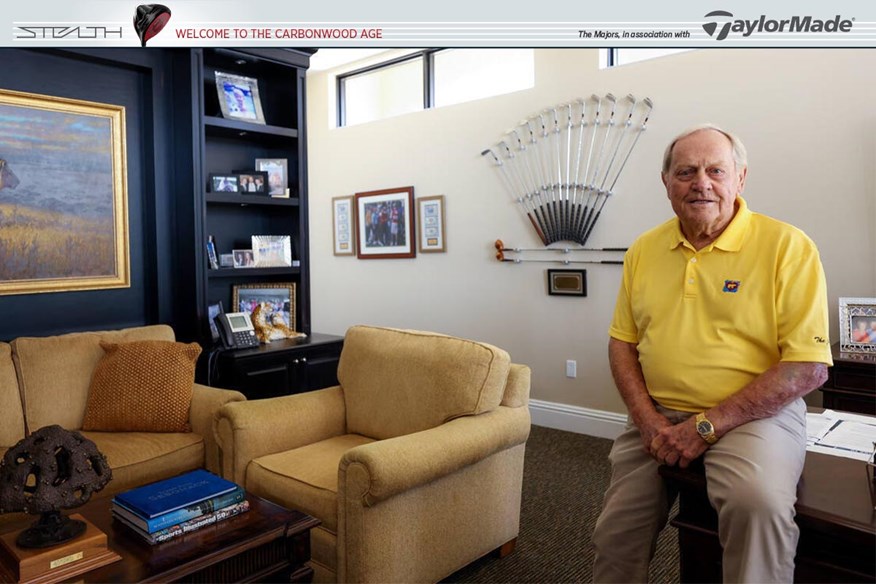EXCLUSIVE: Jack Nicklaus on returning to St Andrews, Tiger, mentoring Rory… and LIV Golf
Last updated:
To mark the 60th anniversary of Jack Nicklaus’ Open Championship debut, Michael Catling visited the Golden Bear’s office in North Palm Beach to reflect on some of his best (and worst) Open memories – and hear why he’s got a special ceremony to attend at St Andrews…
Today’s Golfer’s 2022 Major coverage is brought to you in association with TaylorMade.
The Nicklaus Family Office is a hive of activity. It’s just gone 9am and meetings are already taking place. Phones are being answered. Coffees are being made. But once Jack Nicklaus walks in, everyone stops. Even his own son. He seems oblivious to the aura that he generates, and yet he commands it because of the legacy he has left on the game.
As we follow him into the far office, our eyes are immediately drawn to a bronze statue tucked behind his door. The pose is iconic, capturing his ‘jumping Jack’ pose on the 16th green at the 1975 Masters.
RELATED The 100 Most Influential People In Golf | Jack’s new Scottish golf course
On the wall, there are seven Royal Bank of Scotland £5 notes bearing his face which were printed in 2005 to celebrate his career at The Open. Next to them is a commemorative set of MacGregor irons and persimmon woods which helped him complete the career Grand Slam between 1962 and 1966.
Everywhere you look, there is a piece of memorabilia (and an obligatory Golden Bear) carefully placed between pictures of his wife, Barbara, as well as their five children, 22 grandchildren, and three great-grandchildren.
On his desk, there is a smaller sculpture of his full swing sequence with what appears to be a broken club. It’s the only thing that looks out of place.
Jack Nicklaus doesn’t usually give one-on-one interviews, which makes our 90 minutes with him even more precious. There are no minders, agents or sponsor obligations. Nothing is off limits. Not even the prospect of the LIV Golf Series.
RELATED: Everything you need to know about LIV Golf
“It seems that it is not about the game of golf, but about the money,” he says. “I’m not wild about it.”
Nicklaus has never been afraid to speak his mind. His opinions carry weight because of what he’s achieved in the game. Based on Majors alone, Nicklaus is the most decorated player of all time. He won 18 times and finished runner-up another 19 times. There were also 56 top fives and 73 top 10s to add to the mix.
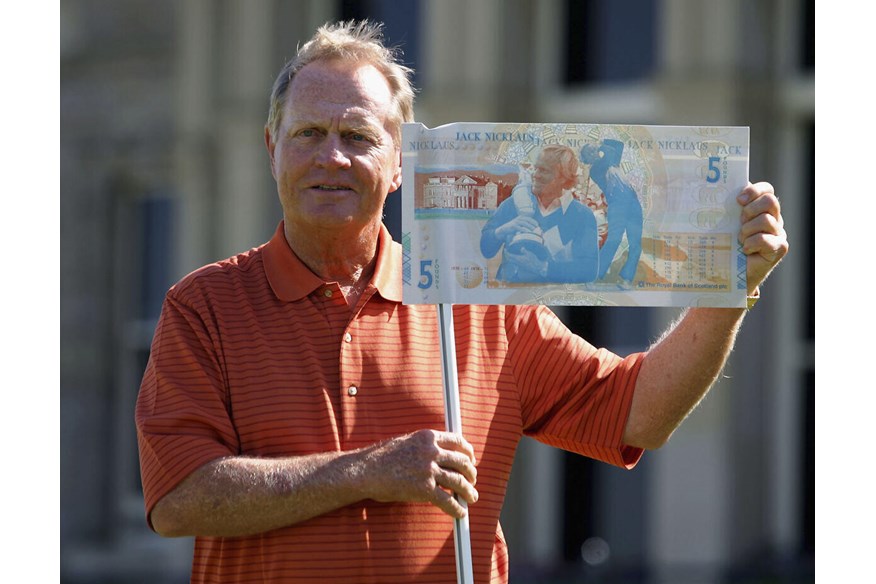
Narrow it down from 1962, when he won his first Major at the US Open, through to his last at the 1986 Masters and he had a win ratio of 19 percent in Major Championships. It’s a frankly absurd statistic which takes even the great man by surprise. “Say that again,” he says, raising his eyebrows in surprise. It’s a rare moment of uncertainty as there’s not much Jack doesn’t know about the game or his game.
The Golden Bear can still recall shots he hit over half a century ago. He can tell you which club he hit. What the lie was like. And which direction the wind was blowing when he came from one back with three to play to win the Claret Jug at St Andrews in 1978.
RELATED: Hole-by-hole guide to The Old Course
He likes to quote Bobby Jones, who famously said, “No golfer’s career is complete until he’s won at St Andrews,” the anointed Home of Golf. Nicklaus won there twice and then retired to a standing ovation in front of record crowds in 2005. He hasn’t been back since.
“I wasn’t going to go back either,” he admits. “I had said my goodbyes. I didn’t want to go back. Peter Dawson had asked me the last time in 2015 and I said no. But now the town is making me an honorary citizen of St Andrews this year, and I couldn’t turn that down.”
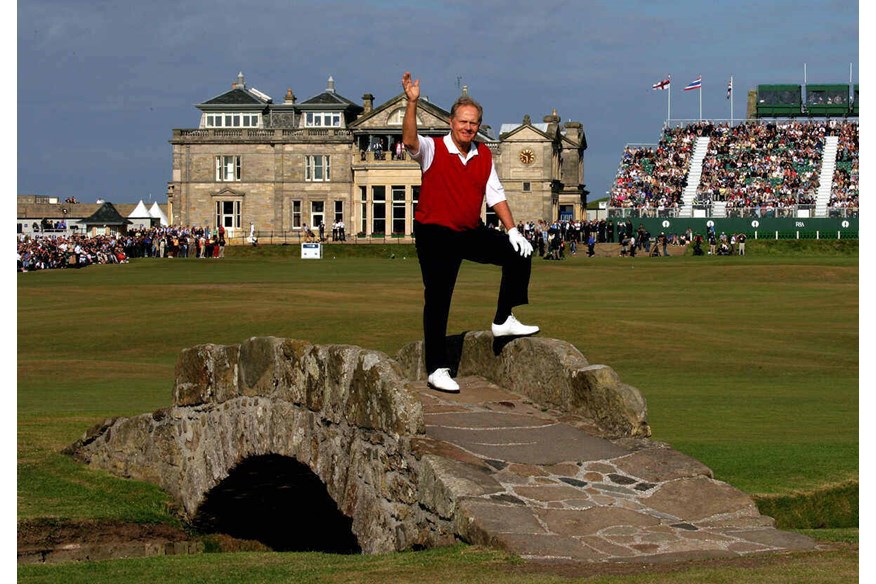
He won’t be playing in the R&A’s Celebration of Champions exhibition, but he will be staying in the same place, just outside St Andrews, where he celebrated in the gardens after his victory in 1978. He has always been a stickler for tradition and routine.
Every year, he would arrive a week before The Open so he could fit in a city break with his wife and daughter, Nan. “The girls enjoyed it. The British Open was always my daughter’s trip. We’d head off on the weekend in between the week of practice. We would go to London or Paris or Munich or some other place. It was kind of fun to do.”
He doesn’t have many regrets, but not making the cut during his St Andrews swansong at the age of 65 still rankles with him. He came close to doing so, but rounds of 75 and 72 meant he missed the weekend by two.
“I think Tom (Watson) was more sentimental than I was. He didn’t stop crying on the bridge. Or my son, Steve. I remember telling him, ‘You need to learn how to look happy when you’re crying’!
RELATED: Rory – “I’d love The Open to be at St Andrews every year”
“I just didn’t want to end my career on that Friday, it was so disappointing. I couldn’t make a putt to save my life. Once I three-putted from the front edge on 17, I wasn’t in a position to make the cut. Knowing the putt on 18 meant nothing, I knew there was no way in the world it wasn’t going to go in. No matter where I hit it, the hole would move in front of it.
“It was still a nice way to go out, making your last putt. I started my Major Championship career when I was 17 years old at the 1957 US Open at Inverness in Ohio by holing a 35-foot putt. So, my first putt and my final putt went in. Not many people have done that.”
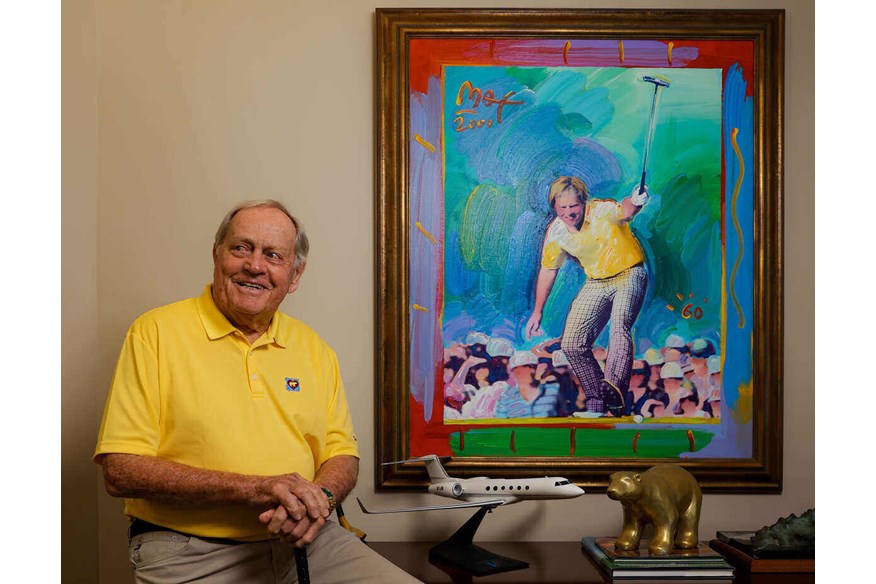
Almost all of the trophies Nicklaus won – replicas or otherwise – can now be found in the Jack Nicklaus Museum, which he implores us to visit in his hometown of Ohio. “It’s about a two-hour deal,” he says, without a hint of hyperbole.
There are more than 2,000 items on display, including numerous clubs, scorecards and a Masters Green Jacket. The museum chronicles each decade of his life, starting with the 1940s, and includes standalone galleries for each of the four Majors, as well as the Memorial Tournament, his family life and course design.
He is still adding to them even now. This month he will follow Bobby Jones in being made an honorary citizen of St Andrews with a civic ceremony, followed by a public reception on Old Street. There are various other commitments before then, including hosting the Memorial Tournament on the PGA Tour for the 47th time.
RELATED: The Old Course – 600 years in the making
He still watches the PGA Tour whenever he can, though you sense he will never understand players who are in contention and choose to ignore leaderboards. “They’re crazy!” he says, shaking his head. He is equally dismissive about how far the ball goes and scoffs at the suggestion that St Andrews could be rendered obsolete by Bryson et al come July.
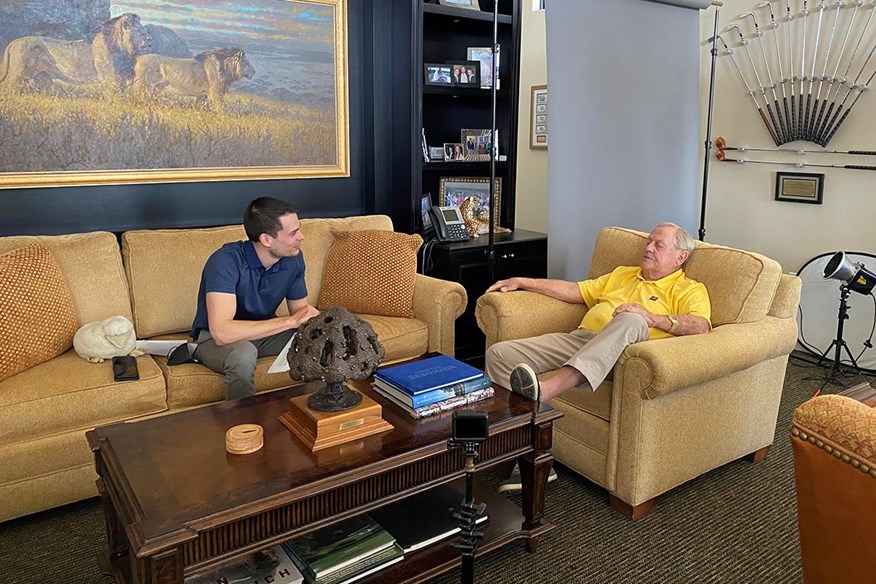
“That won’t happen. There have always been a lot of holes at St Andrews which you can, in theory, overpower, but I don’t think St Andrews has ever yielded itself to excessive power…”
He stops to consider the list of winners before acknowledging that they all hit the ball a fair distance. Himself included. If anything, he was responsible for one of the most iconic shots at St Andrews, in 1970, when he famously removed his yellow jumper so he could open his shoulders more on the 18th tee. That tee shot was so long that it went 360 yards and through the green, setting up a birdie finish to secure a play-off victory over Doug Sanders.
He smiles at the reminder before losing his train of thought. He doesn’t want to focus too much on what happened a day earlier, but more of out of respect for Sanders than his own shortcomings. Most people remember the putt Sanders missed from 30 inches to take the match into a play-off, but Nicklaus still vents over his own performance, which included two three-putts over the last three holes.
“I was never that great around the greens. My weakness was physical. I couldn’t practise putting and chipping. My back was injected in nine different places by the time I was 19. I think that’s why I’m four inches shorter than I was…”
RELATED: Which courses will host The Open next?
His height seems to bother him more than his defeats ever did on the golf course. His attitude was always one of his greatest assets. “If I got beat,” he says, “it was because somebody played better.” There were never any excuses.
“Bobby Jones had a lean spell from 14 to 21 and he told me in a cabin at Augusta that he didn’t become a golfer until he stopped running home to his teacher and learned how to be responsible for his own game. Jack Grout taught me the same way. To take responsibility.
“When I was on the golf course and I didn’t like something in my swing, I would go ahead and correct it in the middle of competition. I did that on numerous occasions and it served me well. In the game of golf, you can only control one person and that’s yourself.
“Losing never bothered me and I never worried too much about it. It was just like, ‘OK, let’s go to next week’. That was probably one of my greatest strengths, being able to lose gracefully and handle it mentally. I think that was very important.”
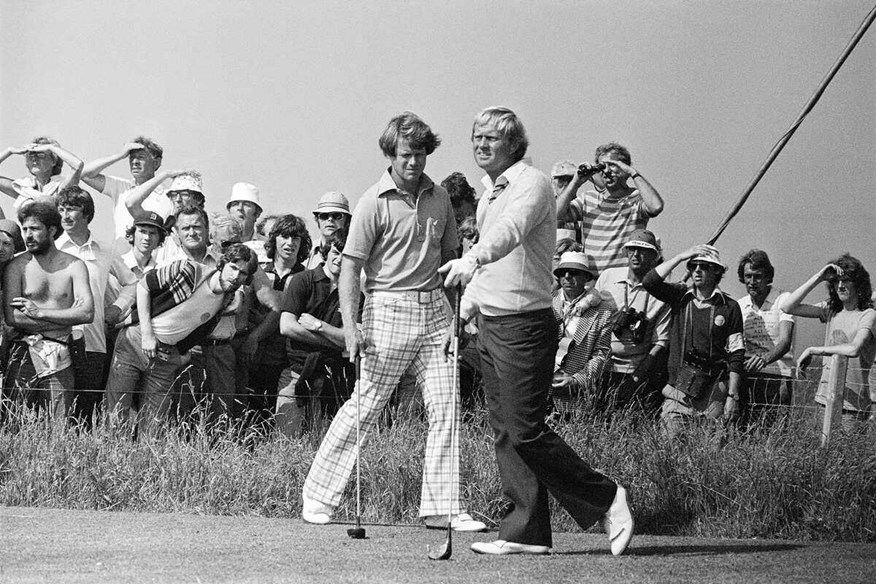
Of the many close calls he had, few stick in the mind quite like 1977 when Tom Watson – the man he cites as his toughest competitor – got the better of him at Turnberry in the legendary ‘Duel in the Sun’.
RELATED: Tom Watson – the modern game’s greatest Open champion
“I never remember as much when I lose,” he says, mischievously. “I remember the pitch at 17 which I hit up close, but I missed a five-foot putt. Then Tom hit it stiff at 18 and I holed a long putt after hitting out of the bushes. That was a good putt, but it was the only chance I had. He was too close. I would have loved to have seen his putt a little bit longer (laughs). But I look back on it fondly really. It was a competitive match which I enjoy, win or lose. Obviously I prefer to win, but it remains a special part of both of our careers.”
Nicklaus has long since settled into the role of family man and elder statesman. His own golf game is almost non-existent nowadays. He still participates in the ceremonial tee shot at the Masters, but only out of respect for what it stands for. “I can barely hit it past my own shadow,” he says. “My body doesn’t let me.”
He is supposed to be winding down now and yet he still visits the office most days to check in on his charitable initiatives and his hugely successful course design business.
RELATED: Ivor Robson: My life as the voice of The Open
His fingerprints can be seen on almost 320 course designs worldwide, though few are more famous than Muirfield Village Golf Club. The course itself was modelled on Augusta National but it’s no coincidence that it shares the same name as the course where he won the first of three Claret Jugs in 1966. It was also the place where his love affair with links golf began.
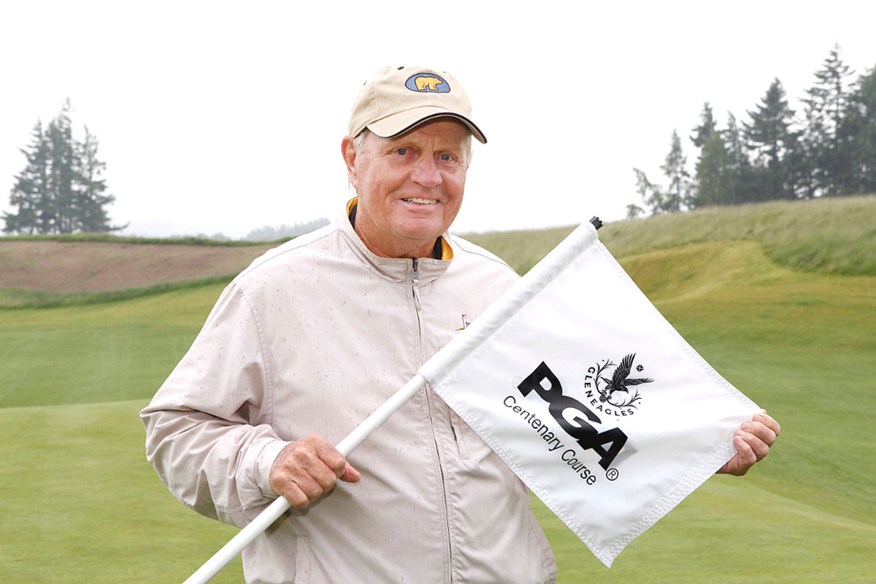
Nicklaus was 19 when he made his first trip overseas to play at Muirfield in the 1959 Walker Cup. It left a lasting impression. In The Greatest Game of All, his first biography, he revealed that “after Muirfield, I had a deeper confidence in my ability to produce a good golf shot when I had to… and more confidence, too, about my capacity to function under pressure”.
Nicklaus won both matches that week and stayed on to make his first and only appearance in the British Amateur, losing 4&3 in the quarter-finals at Royal St George’s. It remains one of only two courses on The Open rota, alongside Royal Troon, where he never finished first or second.
“I didn’t realise that,” he says, before the competitor in him points out that he did win the Royal St George’s Grand Challenge Cup as an amateur.
Still, he had to wait until 1962 before he was eligible to play in The Open Championship, by which time he was already a Major winner and a major star after beating hometown hero Arnold Palmer in the US Open at Oakmont earlier that summer.
“Looking back now, I was a 22-year-old with blinkers on,” recalls Nicklaus. “It didn’t matter that I was up against some bloke called Palmer who lived just next door (laughs). I had finished second and fourth in the two previous US Opens so I was like, ‘This one is mine’.”
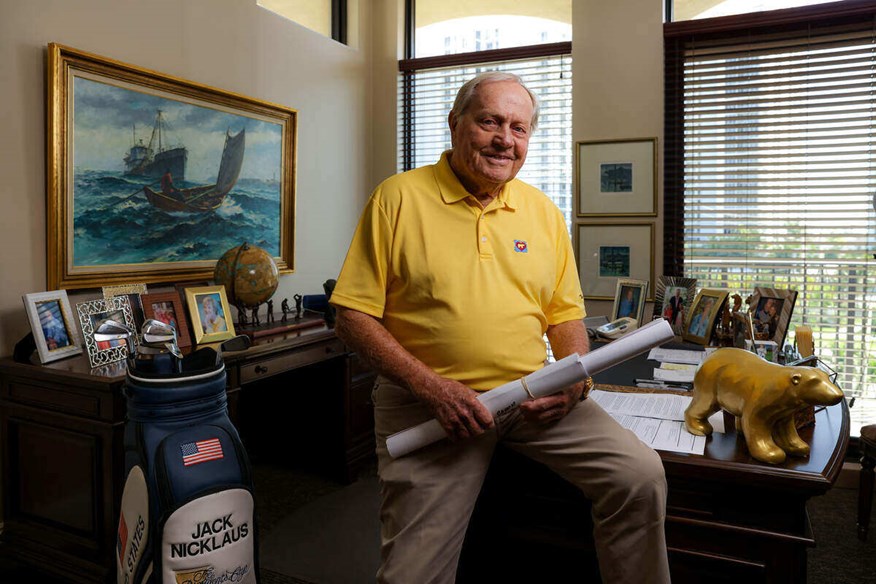
The rewards were plentiful. He made the cover of Time magazine and arrived for the start of The Open at Royal Troon with a big-bucks endorsement deal to play Slazenger clubs in Europe.
Everything was going great until he used the irons for the first time in a practice round and started spraying everything right. They were so ill-fitting that he spent much of the week in the pro shop, trying to tweak anything and everything. It didn’t work.
RELATED: Britain’s Best Links Golf Courses
He followed an opening round 80 with a 72, 74 and 79 to finish in a tie for 34th, a vast 29 strokes behind Palmer’s winning total. His recompense was all of £55. “I don’t remember much about my opening round except I made a 10 on No.11,” he says, shrugging. “I got into the gorse and couldn’t get out.”
It took another four attempts before he finally got his hands on the Claret Jug. There was an agonising defeat at Royal Lytham & St Annes in 1963 when he bogeyed the last two holes to lose by a shot – “I gave that away,” he declares – and then he got on the wrong side of the draw at St Andrews a year later.
By the time he returned to Muirfield as the Masters champion in 1966, Nicklaus was starting to field questions about whether he had the discipline to play links golf. It would prove to be a seminal moment.
“Muirfield was supposedly a golf course that wouldn’t suit my game,” he remembers. “The rough was knee-high, right on the edge of the fairways, and I only hit my driver 17 times. I remember the last one went too far into the bunker on 14 and I made bogey. That almost cost me the tournament… ”
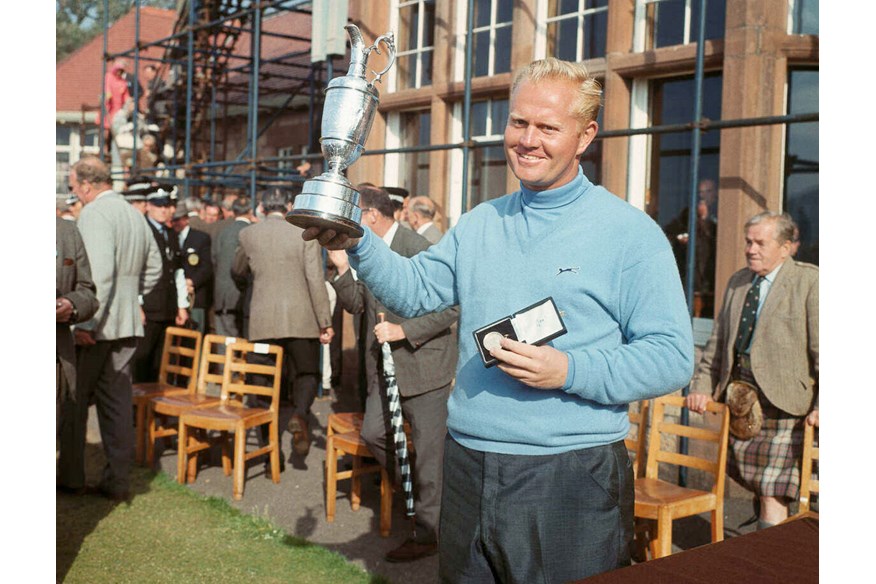
A final-round 70 was still good enough to deliver the career Grand Slam, joining an iconic list of champions – Gene Sarazen, Ben Hogan and Gary Player – who had won all four Majors. Not that it meant much to him at the time. “I never even thought about it; it was never a subject then.”
Of greater significance, he says, was how he relied more on his course management than his prodigious length off the tee. It would be a stretch to say he cracked links golf that week, but his record and consistency thereafter was extraordinary. Over the next 15 years, Nicklaus never finished outside the top six in any Open Championship, a run that ended in 1982. The only surprise is that he didn’t win more than three.
RELATED: How can I get tickets to The Open?
“I played well there virtually every time, apart from Troon when I first started out and Birkdale three years later. But every other time I was always in contention. I had seven seconds at The Open. I could have won a few of those. I don’t have a lot of regrets, but I probably threw away a couple. I probably wasn’t as focused on some of them as I could have been.
“Had I known a fella named Eldrick Woods was coming along, I might have done more. But I think that would have been at the expense of what has been the core of my life, which is my family. Golf has always been just a game for me. It was never my priority; my family was.”
Nicklaus is 82 now, but he remains every bit as insightful and relevant as the younger men who continuously see his counsel. A week ago he was at The Bear’s Club in Florida with Rory McIlroy for over half an hour. It’s a kind of mentorship which he clearly enjoys.
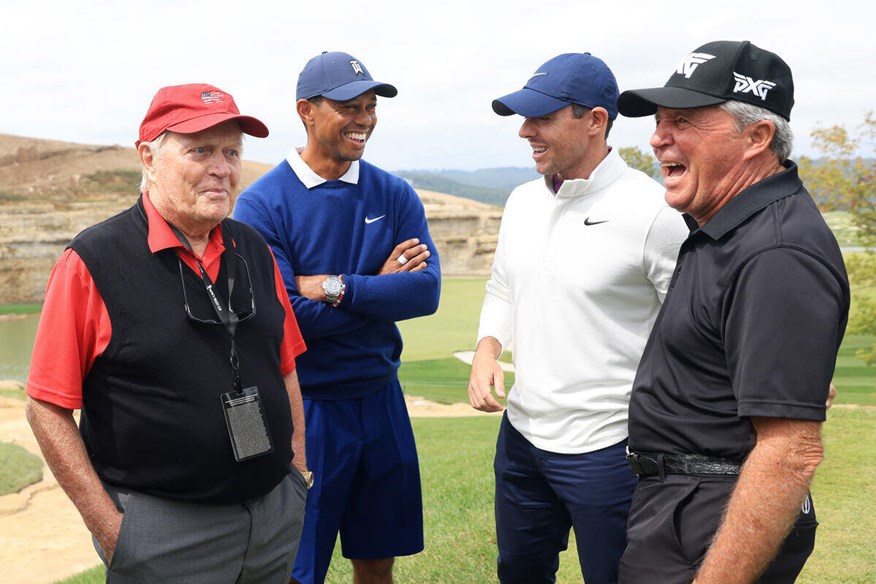
“I speak to Rory as much as anybody,” admits Nicklaus. “I speak to Justin Thomas and Jordan Spieth quite a bit. Dustin Johnson as well. One of the first players who came to me asking for advice was Trevor Immelman. He asked me how to play Augusta, I told him and he went away and won it. After that, Charl Schwartzel came to me, asked me the same thing and he won.
“It’s funny because Patrick Cantlay asked me how to play my Muirfield and he’s won twice, so maybe I have helped some of them. It amazes me that they want to listen to me, but I get flattered by that. And it keeps me current.”
Nicklaus knows it won’t be long until all the old comparisons and what-if questions start up again around Tiger’s latest comeback. He has a “tendency to doubt” whether he will even be able to win again, but he would never be so foolish as to write him off completely. “Never count out Tiger,” he says with the caution of a man with a record to lose.
As for the debate about who is the greatest golfer of all time, Nicklaus doesn’t care to speculate. He says it’s not important, but the wry smile suggests otherwise. “That’s for the people to determine. I think my record speaks for itself…”
RELATED: Who’s playing in the 150th Open?
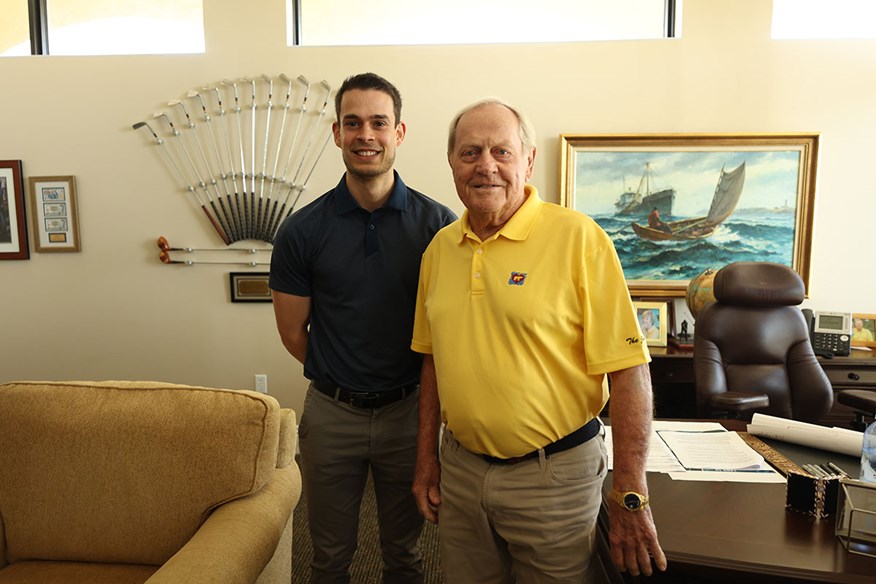
JACK NICKLAUS’ TAKE ON…
Living up to his own high standards
“I think I underachieved all my life. I think that’s why I got better. I think that if you feel you’re overachieving, or getting more out than what you should get, then you stop working. I always wanted to climb a mountain. I always wanted to get better so I just tried not to believe anything about what I would read or what I would hear or even what I thought.”
His three favourite shots
“They were all hit with a 1-iron. In 1967 at Baltusrol in the US Open’s last round, I had 238 yards left on the final hole. It was uphill, into the wind, and I hit a 1-iron over the bunker and onto the green. I then made the putt to break Hogan’s US Open scoring record. Then, in ’72 at Pebble Beach (again in the US Open), I was on the 17th and had to get pretty creative because I wasn’t sure whether I could reach and get it over the front bunker. I ended up hitting the pin.
The final one was in ’75 at Augusta in the last round. I was in the centre of the fairway and I had 242 yards off one of those little humps. I didn’t make the putt, but I hit it to within 12ft or something like that.”
The shots he’d like to have back
“Trevino’s chip on the 17th at Muirfield in ’72 and Watson’s chip on 17 at Pebble Beach in 1982.”
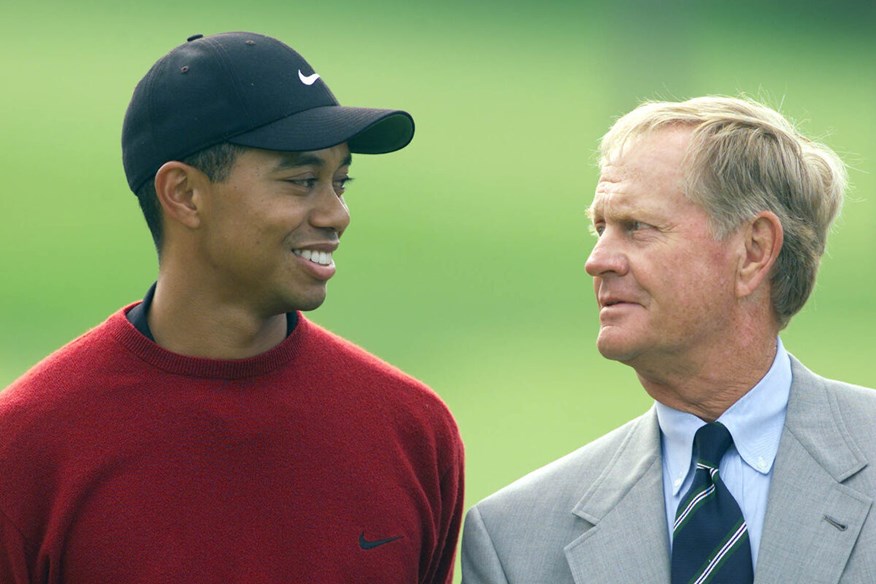
That fella named Eldrick Woods
“He is probably the most dedicated and determined young man I’ve ever met. He’s got an unbelievable skill level and work ethic. Tiger’s weakness, even though he had the length, was accuracy off the tee. He aimed at the world and missed it, but he got up and down from unbelievable places.”
RELATED: Open legends: Tiger Woods
The Concession at the Ryder Cup
“I knew if (Tony) Jacklin and I tied the last hole we would retain the (1969) Ryder Cup. I also knew Jacklin was the British Open champion and I’m pretty big on sentiment and not wanting to destroy something or someone. Tony had been a good friend and you can imagine how the press would have murdered him if he’d have missed that putt. I didn’t want that to happen. All my team members thought it was the right thing to do.
All the Ryder Cup captains I’ve asked about it since have said they hope their guy would do the same. The only guy who didn’t like it was my captain, Sam Snead. Sam was a guy who wanted to bury everybody, but that was not my personality. I loved Sam, but he could not stand to lose. He always wanted and had to win.”
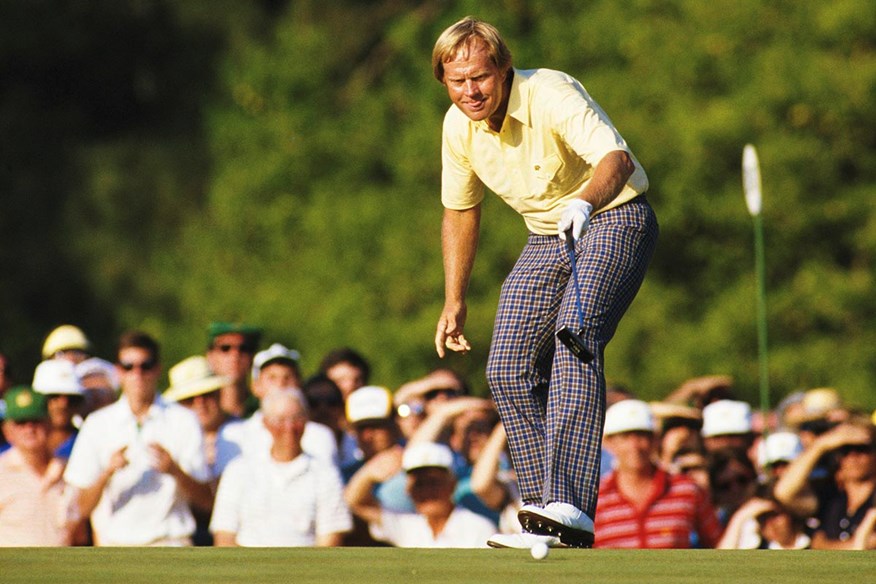
JACK NICKLAUS’ CAREER IN NUMBERS
3 Open victories – 1966, 1970 and 1978.
4 Consecutive years winning a Major Championship – 1970-73.
6 Green Jackets – 1963, 1965, 1966, 1972, 1975 and 1986.
7 Runner-up finishes in The Open Championship.
8 Major Championship victories when trailing after 54 holes.
9 US Open (4) and PGA Championship (5) titles.
13 Longest streak of top 10s in Majors (1973 Masters-1976 US Open).
16 Top-five finishes in The Open, including 11 consecutively.
19 Runner-up finishes in Major Championships.
26 Age when he completed the career Grand Slam.
39 Consecutive cuts made in Major Championships.
73 Top 10 finishes in Major Championships.
164 Starts in Major Championships, a record.
£5,250 Jack’s winner’s cheque at the 1970 Open Championship.
READ NEXT: The 40 moments that defined The Open
-
 Jack Nicklaus will be made an honorary citizen of St Andrews
Jack Nicklaus will be made an honorary citizen of St Andrews
-
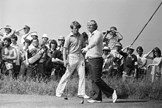 Tom Watson famously got the better of Jack Nicklaus in the Duel in the Sun
Tom Watson famously got the better of Jack Nicklaus in the Duel in the Sun
-
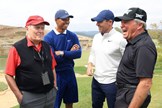 Jack Nicklaus is widely considered to be the greatest golfer of all time
Jack Nicklaus is widely considered to be the greatest golfer of all time
-
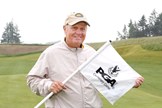 Jack Nicklaus has worked his magic in Scotland, designed the PGA Centenary Course at Gleneagles.
Jack Nicklaus has worked his magic in Scotland, designed the PGA Centenary Course at Gleneagles.
-
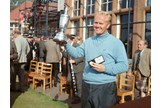 Jack Nicklaus completed the career grand slam at the 1966 Open
Jack Nicklaus completed the career grand slam at the 1966 Open
-
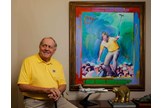 Jack Nicklaus poses at his family office in Florida
Jack Nicklaus poses at his family office in Florida
-
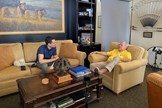 Jack Nicklaus chats to Today's Golfer Features Editor Michael Catling.
Jack Nicklaus chats to Today's Golfer Features Editor Michael Catling.
-
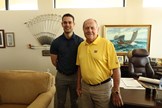 Jack Nicklaus with Today's Golfer Features Editor Michael Catling.
Jack Nicklaus with Today's Golfer Features Editor Michael Catling.
-
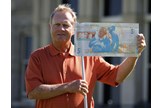 Jack Nicklaus was presented with a £5 note bearing his face
Jack Nicklaus was presented with a £5 note bearing his face
-
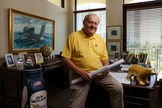 Jack Nicklaus has helped design over 400 golf courses worldwide
Jack Nicklaus has helped design over 400 golf courses worldwide
-
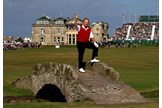 Jack Nicklaus retired at the 2005 Open at St Andrews.
Jack Nicklaus retired at the 2005 Open at St Andrews.
-
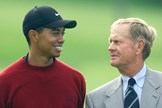 Tiger Woods has 15 major wins, Jack Nicklaus has 18.
Tiger Woods has 15 major wins, Jack Nicklaus has 18.
